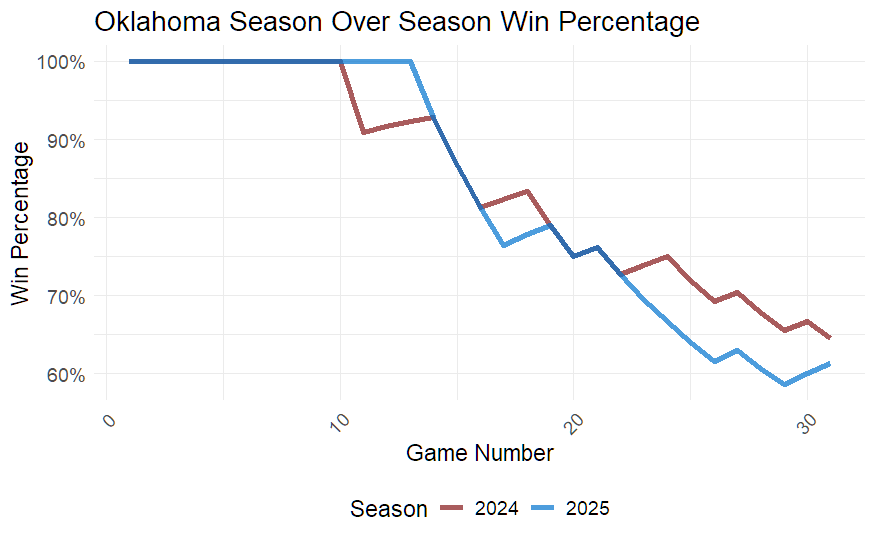Soon You’ll Understand
The conference tournaments are set, and even though some games have yet to be played, several teams' seasons are already over. This analysis examines the three ACC and Big Ten teams that missed their conference tournaments, evaluating how close they came to an NCAA Tournament bid if they had swept their actual non-conference schedules. Unlike my previous hypothetical approach, this piece is grounded in the results of games they actually played, and the teams who missed their respective tournaments.
It might seem unlikely for a team to go undefeated in non-conference play yet finish near the bottom of their conference standings. However, Oklahoma just pulled off this exact scenario. They started 13-0 in November and December but ended up as the 14th seed (out of 16) in their conference tournament after going 6-12 in conference play. Remarkably, this is the second straight year Oklahoma has experienced a similar fate. Last season, they started 12-1 but finished 8-12 in the Big 12, narrowly avoiding one of the worst conference records.
Oklahoma is firmly on the bubble this season and was the first team out in 2024. Though they have not played in a conference that disqualifies teams from the conference tournament, they still serve as an example of how a strong non-conference schedule can influence the tournament bubble.
Death Row East
Duke, Louisville, and North Carolina played the most competitive schedules before conference play, each facing at least six Quad 1 and Quad 2 opponents. As seen in the graph below, only Duke and Pitt had more wins than losses in the top two quadrants, while Florida State and Boston College not only failed to win in these quadrants but also played three such games combined.
At the bottom of the chart, we find the three teams that didn’t qualify for their conference tournament: NC State, Boston College, and Miami. These teams combined for an 0-10 record in the first two quadrants.
Boston College can be removed from this discussion immediately. Even with an 11-0 start, a 10-0 record against Q3 and Q4 teams does nothing for an NCAA tournament resume.
Miami’s case is more interesting. Head coach Jim Larrañaga likely doesn’t retire mid-season if they had a better non-conference performance. Miami’s 4-7 start included two Quad 1 opportunities (Tennessee and VCU) and three Quad 3 games. The Shriner’s Children’s Invitational provided two of those Q3 matchups, while their SEC/ACC Challenge game against Arkansas was another. Interestingly, had Miami beaten Drake in their tournament opener, they would have played FAU in the semifinals and Vanderbilt in the final—swapping a Q1 loss for a Q1 win and a Q3 loss.
While Miami’s loss to Drake wasn’t the single turning point, it marked the beginning of their downward trajectory. In conference play, their three redeeming wins were all in Q3, paired with six losses in both Q1 and Q2. That left them at 5-12 in those top two quadrants. Compared to other bubble teams like Texas, Miami’s six additional losses outside Q1 and Q2 ended any serious NCAA tournament hopes.
Similarly, NC State coach Kevin Keatts might still have a job if his team had performed better early. NC State played four Q1 and Q2 games (BYU, Purdue, Kansas, and Texas), winning some, which could have improved their standing. Unlike Miami, NC State had fewer bad losses, with only three coming in Q3 and Q4. They also secured two Q2 wins and one additional Q1 opportunity in the non-conference.
Adding it all up, NC State would have been 6-12 in Q1 and Q2, with three fewer bad losses than Miami and an additional Q1 win. How does that compare to other bubble teams?
*Villanova’s additional loss was in Q4, while the others were in Q3.
Memphis has a strong tournament foothold, with an 11-2 record in Q1 and Q2. Meanwhile, NC State’s case would place them in the "next 8 or next 12 out" range, earning a bid to the NIT.
As if Waltz
In the Big Ten, bad losses were less frequent than in the ACC. Teams playing fewer Q3 and Q4 opponents—such as Louisville, Illinois, and Purdue—had more difficult schedules overall. The Big Ten’s competitiveness ensured that most teams avoided playing more than three games against weak competition.
Among the three teams that missed the Big Ten tournament, Penn State stands out. Their non-conference slate included only one Q1 or Q2 game. While they had strong conference wins against Purdue and Wisconsin, their 14 conference losses—including only one outside Q1+Q2—weren’t enough to compensate.
Nebraska and Washington played nearly identical schedules, with Nebraska playing one extra Q3+Q4 game in conference play. Washington’s three tough non-conference games all fell in Q2, but with only two Q1+Q2 wins in conference play, they never had a real shot at the tournament.
Nebraska, however, had four Q1 wins in conference play and was briefly in bubble discussions. However, a five-game losing streak—including a Q3 loss—eliminated them from contention. Their 7-13 Big Ten record tied with four other teams, but they lost out on tiebreakers.
Had Nebraska beaten Saint Mary’s in a neutral-site Q1 opportunity, they would have entered conference play undefeated. That game was close—Brice Williams had a chance to tie it with a buzzer-beating three. If he had made that shot and Nebraska had won, they would have been 10-11 in Q1+Q2 games, placing them firmly in bubble discussions come Selection Sunday.
We were a single possession game from this being a real resume discussion compared to the hypothetical nature of this piece.
-BM










